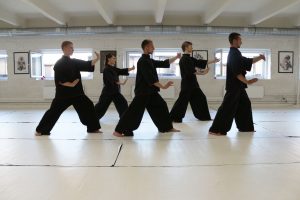Who should try tai chi
Tai Chi gymnastics would be a great choice if you:
- Have crossed the 50-year mark and are looking for a safe way to increase your physical activity.
- Are recovering from surgery or injury and are at a stage where you can already incorporate physical activity.
- Looking for a way to increase physical activity, but haven’t exercised in a while and can’t tolerate fitness in any form.
- You want to reduce stress and anxiety, increase awareness and find harmony with yourself.
Tai Chi is suitable for people of all ages and has virtually no contraindications. However, there are conditions for practicing tai chi: A gentle way to deal with stress when you should consult a doctor before exercising:
- Pregnancy.
- Joint and spine problems.
- Deteriorating osteoporosis.
- Hernias.
Who shouldn’t do tai chi
Tai chi is not suitable for you if you want to:
- Lose weight, increase muscle mass and develop endurance.
- Improve your athletic performance in any sport.
- Learn self-defense techniques that will allow you to effectively defend yourself against opponents.
- Gentle gymnastics does not provide enough stimulation to improve the physical fitness of healthy young people.
Which style of tai chi to choose
All styles of tai chi include gentle and flowing forms that are constantly changing. However, there are some differences that may affect your choice.
4 Family Styles of Tai Chi
There are currently several main styles of tai chi:
- Chen. This is the oldest style of tai chi, most reminiscent of a martial art. In addition to the soft and smooth movements, it includes jumps, explosive elements, kicks and punches. Unlike other forms, Chen provides cardio exercises and is more commonly practiced by young people.
- Yang. The most popular style that incorporates broad majestic movements. It lacks jumps and stiff arm and leg technique, so the style is suitable for people of all ages and abilities.
- Wu. The second most popular style of tai chi. It includes deviations of the body from the central line. While bending and unbending the body, a standing leg serves to keep the balance. The movements in the Wu style are less amplitude than in the Yang forms.
- Sun. Includes a combination of different styles of tai chi and martial arts elements. The style is characterized by unique footwork and soft circular hand movements.
For beginners, Yang and Wu variants are best suited – they are also most often taught in Russian schools and fitness centers. These styles give minimal strain on muscles and joints. If you are looking for something more active, choose Chen style: it will help you increase leg power, improve stretching and pump up the body’s endurance.
What you need to practice Tai-Chi
This practice does not require special equipment or clothes. It is enough to choose comfortable clothes that do not cramp your movements. You can take off your shoes and practice barefoot or find soft and non-slip sneakers with a thin sole that do not restrict the movements of the foot.
It is best to begin to master the practice with a coach who will help you learn the forms and monitor the correctness of their performance and breathing. If there are no courses in your city or you want to master the practice on your own, try to practice on the instructional videos.
How to practice Tai Chi at Home
Forms of Tai Chi in different styles may differ from each other by name or the way they are performed, but they all share the same basic principles: smooth continuous movement, breathing and control of body position. As a rule, the training begins with a warm-up, which helps to warm up the muscles and tune in to the class.


